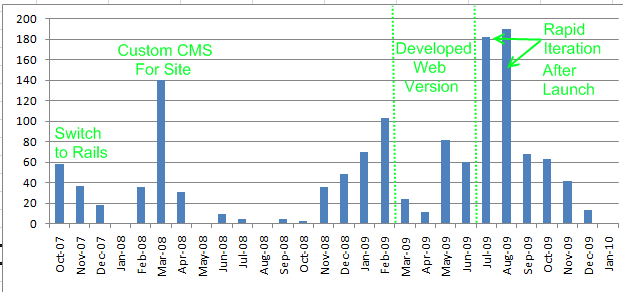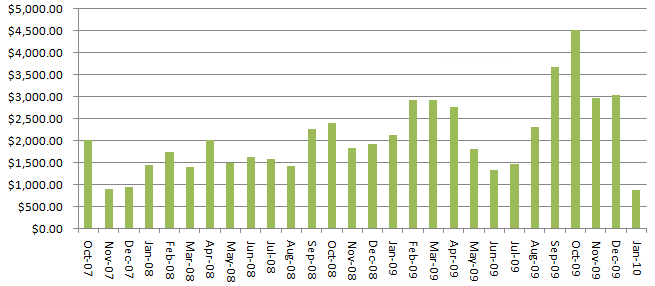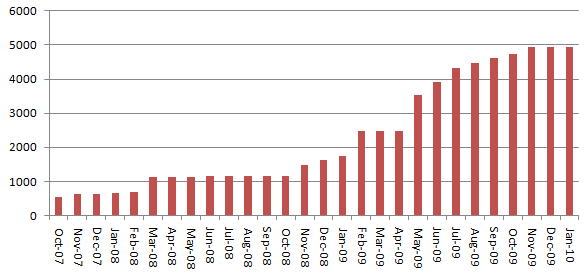I was curious today about whether I tend to work consistently or in bits and spurts, so I decided to check by asking my SVN repository. First I dumped all my commit messages since I started using SVN (back in October 2007, which was over a year after starting my business — I know, I know, I was young and stupid once) into a text file.
Then, I parsed the file with a quick Ruby one-liner to pull out how many commits were made in each month. My commits when I’m working in Rails can range from a single character to a feature worth of code, but I figure over the years the variation probably averages out.
I then dumped them into Excel 2007 (totally worth the price just for the pretty graphs, although if I was doing this dynamically I’d do it differently) and annotated the graph in Paint.NET.

You can probably tell a lot about me from the shape of this graph:
- I tend to work in spurts when I have inspiration.
- I prefer to ship v1.0 of something and iterate like mad rather than spending more time shipping something more ambitious to start with.
- I sometimes get slammed by the day job and am left with no energy for the business. (See, e.g., summer of 2008.)
What you can’t tell from the shape of the graph is that, happily, code is not everything in the software business. Here’s another graph which I’ve truncated to fit the same time scale:

I had another thought: why not visualize code bloat how much valuable code I’ve written over the years. So I checked out a copy of revision 1 into a temporary directory, then used
another Ruby script to step through each revision and use
rake stats to count how many lines of code were present.
I really don’t recommend doing this at peak time for the server with your SVN repository on it, incidentally, as it is wasteful as heck. This script took about half an hour to execute on my slice. Two ways to improve it: number one, use a local copy rather than using svn+ssh to grab the code. Number two, instead of
rake stats use a purpose-built code counter like
CLOC, which doesn’t require loading the entire Rails framework to run. Loading the entire Rails framework 1,334 times will not make your CPU happy. Of course, smarter than any of these options would have been figuring out what revisions I wanted to look at a priori, and then just looking at those ~20 revisions rather than deep scanning all 1,334 of them.
Then I
combined the per-revision LOC counts with the SVN log to graph dates against code size. Tada!
I guess slow and steady wins the race.
I saw the title Will Single Founders Please Stand Up and got a bit inspired. Substantive comment continues below the song. With apologies to Eminem, Weird Al, and fans of quality music everywhere:



